W&M receives $1.2M from HHMI for science education
"HHMI is committed to funding education programs that excite students' interest in science," says HHMI President Robert Tjian. "We hope that these programs will shape the way students look at the world-whether those students ultimately choose to pursue a career in science or not."
William & Mary is one of 50 research universities in 30 states and the District of Columbia selected in this latest round of four-year grants awarded through HHMI's Precollege and Undergraduate Science Education Program.
"William & Mary's continued support from Howard Hughes reflects the extraordinary quality of our faculty and students as well as the strength of our interdisciplinary approach to science. In the current era of financial stringency, HHMI's support is especially telling," said President Taylor Reveley.
The May 20 HHMI announcement marks William & Mary's fourth consecutive receipt of the funding, says Margaret Saha, Chancellor Professor of Biology and director of the HHMI program at the College.
She said the HHMI initiative at William & Mary involves several departments, "dozens and dozens of faculty members and literally hundreds of students." There is a strong outreach component, as well, which will benefit high-school science labs and students transitioning to college. Saha said the versatility of the Precollege and Undergraduate Science Education Program is one of its strengths.
"HHMI is just absolutely wonderful about stimulating innovative approaches and novel programs, and letting each institution tailor its initiatives to its own environment-its mission, needs, students and faculty," Saha said.
At William & Mary, the program will have four major components, Saha said:
1. Student research
HHMI will fund 20 positions for full-time summer research for undergraduates, in addition to a freshman research program. The summer researchers can also apply for mini-grants for lab supplies or travel expenses. "Students who are first authors on posters or scientific talks can apply to obtain funds to present at national meetings," Saha explained.
2. Faculty development
The grant will allow the College to hire an interdisciplinary biomathematics faculty member. "This person will strengthen the quantitative approaches that are becoming essential in all aspects of contemporary biology," Saha said. In addition, William & Mary will continue an extremely successful summer collaboration program with faculty and students from historically black colleges and universities (HBCUs). Each summer, five faculty members from HBCUs (and their students) work with William & Mary researchers in their labs. "We form mutually beneficial and, hopefully, long-lasting collaborations," Saha said.
3. Curriculum development
Saha said that William & Mary will expand the concept of its freshman bacteriophage labs, a separate initiative funded by HHMI. New programs introduce freshman labs to the bacterial diversity found in College Woods. Initially, a five-week unit for introductory biology students, the HHMI grant will allow faculty to expand the College Woods initiative into a year-long study. Saha said a study of the effects on gene expression of mercury in the ecosystem will be expanded as well, allowing more students to engage in authentic research activity early in their careers.
Another element of curriculum development that the grant will make possible is the incorporation of mathematics into the introductory biology courses. "This will get biology students over any fear of mathematics early," Saha said.
There also will be curriculum enhancement in the upper-level undergraduate courses, including a new genomics-proteomics course that serves as a more advanced continuation of the freshman phage lab. Saha explained that there also will be a new course in "eco-devo," or ecological-developmental biology, an emerging interdisciplinary field that deals with the effect of ecological phenomena on the development of an organism.
"A developing organism, even if it's in the womb, is still prone to being affected by all kinds of environmental agents," Saha explained. "There's a continual interaction between genes and the environment. This field is becoming more important because of all the new compounds we are routinely introducing into our environment, ranging from new medications to novel plastics to food additives. Discerning the effect on developing organisms is extremely important."
4. Outreach
"We will be reaching out to local teachers with workshops and update courses in aspects of the sciences that they don't usually get on a regular basis," Saha said. Teachers will attend workshops at William & Mary, receiving material and instruction that lets them go back to their schools and conduct lab experiments with their students. Saha pointed out that the labs are chosen to be in line with Virginia's Standards of Learning (SOL) curricula and tests.
She said that another aspect of the outreach component will be a transition program for science-bound rising freshmen at William and Mary. Working with existing pre-college programs, the grant will bring students from disadvantaged backgrounds to campus for several weeks before their first semester at the College. "We'd like to have them work in a lab and become part of the lab research community, something which will provide a support system for the transition to the college environment," Saha explained.
The 50 grants to research universities were part of a $79 million grants package announced by HHMI on May 20. HHMI, the nation's largest private funder of science education, has spent $1.6 billion since 1985 to reform life sciences education from elementary through graduate school. At the undergraduate level, HHMI's strategy leverages the advantages of working both with institutions and individual professors, explains Peter J. Bruns, HHMI's vice president for grants and special programs.
The grants allow large research universities to tackle projects that affect hundreds or even thousands of students, both inside the university and at local K-12 schools, Bruns says.
 Skip to main content
Skip to main content

